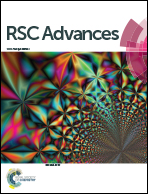Efficient photocatalytic degradation of bisphenol A and dye pollutants over BiOI/Zn2SnO4 heterojunction photocatalyst†
Abstract
BiOI/Zn2SnO4 composites with a heterostructure have been synthesized via a chemical deposition method under mild conditions by tuning the BiOI mass ratios. The physicochemical characteristics were investigated by X-ray diffraction (XRD), diffuse reflectance ultraviolet-visible light spectroscopy (DRS), scanning electron microscopy (SEM), and high-resolution transmission electron microscopy (HRTEM). The XRD results show that two phases of BiOI and Zn2SnO4 co-existed in the composites. The HRTEM image showing clear lattice fringes proves the formation of a heterojunction at the interfaces of BiOI and Zn2SnO4. The photocatalytic degradation of the endocrine disruptor bisphenol A and dyes (MB and RhB) indicated that the BiOI/Zn2SnO4 composites were more photoactive than pure BiOI and Zn2SnO4. The activity enhancement was mainly ascribed to the formation of a heterojunction between BiOI and Zn2SnO4, which facilitated the transfer and separation of photogenerated electron–hole pairs. The photoelectrochemical measurement has also confirmed the enhancement of the separation efficiency of electron–hole pairs.


 Please wait while we load your content...
Please wait while we load your content...